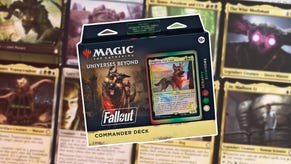Seven Essential Ingredients for a Successful eSport
COVER STORY: A few things for developers to keep in mind while they try to build the next great eSport.
This article first appeared on USgamer, a partner publication of VG247. Some content, such as this article, has been migrated to VG247 for posterity after USgamer's closure - but it has not been edited or further vetted by the VG247 team.
Making a successful eSports as much as an art as it is a science. Sometimes you just have to be in the right place at the right time. That said, there are a few things that developers should keep in mind when building up an eSport, which I've listed below. An eSport can succeed without one of these items, but it's exponentially harder. Here are some essential ingredients for developing a successful eSport.
1. It has to be easy to grasp...
Why it's important: Developers seem to trip over themselves on this point a lot. In the rush to make an eSport deep enough to be interesting, it's quite possible to wind up a with a game that only a handful of people understand or want to play. Battleborn may wind up suffering from this problem. To tell you the truth, even after spending a solid afternoon with Battleborn's multiplayer, I barely remember its various modes. All I remember is that its kind of a mash-up of Team Fortress and League of Legends.
With that said, not every game needs to be a Rocket League. MOBAs like DotA 2 are extremely complex, but they still enjoy large followings. On the other hand, MOBAs have been around long enough now - more than a decade at this point - that a lot of gamers have a decent grasp of the rules. And anyway, MOBAs have one overriding rule: Do your job. As long as you're in the proper lane and you're not dying constantly, you're probably fine. It helps that Riot in particular has long had a fantastic onboarding process of League of Legends.
Still, while you can get away with a certain amount of inherent complexity, it helps to keep things as simple as possible. Rocket League jumped out at people because of its extremely simple but understandable concept: RC cars playing soccer. In fact, there's a reason that soccer itself the most popular sport in the world. The easier a game is to understand, the more likely you are to get a large audience from the start.
Ultimately, if you can easily grasp the rules of the game, you have a much better chance of enjoying the competitive side, whether as a view or a player. Cloud9 owner Jack Etienne puts it this way when talking about Super Smash Bros. Melee, which is one of the easiest competitive games to pick up and play: "Almost everybody's played [Super Smash Bros. Melee], so people have a personal reference point with the game. So, I think everyone can just watch it and kind of understand what's going on, and then you really appreciate how good these guys are, and the players themselves get so pumped."
Who does it best: Blizzard, of course. They have a knack for making even complex card games like Hearthstone appealing to a mass audience. Strong tutorials, friendly interfaces, and excellent art make it easy for new players to engage with Blizzard's games. After 20 years, Blizzard more or less has engaging new players down to a science.
2. ... But deeper than it looks
Why it's important: This point should be fairly obvious. If a game doesn't have depth, it's unlikely to attract a dedicated audience. Rocket League has managed to retain a large and dedicated following in part because advanced techniques like aerials require so much skill, in turn pushing hardcore players to practice until they get good enough to reliably execute them.
One of the weirder examples of this is Super Smash Bros. Melee, which has somehow become an eSport despite the best efforts of its own creators. This goes back to the principle of being easy to understand - Smash Bros. Melee built a large and dedicated audience on the back of being simple, fun, and loaded with nostalgia. Melee's tournament scene grew organically out of that community; and in the course of trying to gain an edge over the competition, competitive players discovered techniques like Wavedashing and Waveshining. Melee remains arguably the most popular game in the series among competitive players in part because of these techniques.

Depth can be a double-edged sword, though. Lean too heavily on advanced techniques, and a certain segment of the community will start to feel as if they will never be able to keep up and ultimately disengage. The fighting game community in particular has struggled with this issue. One reason MOBAs are so popular is that there's a general feeling that anyone can excel at them as long as they take the time to study the tactics and learn the characters. Sometimes it can't be helped - some people will just always be better at a game like Counter-Strike: Global Offensive because they have better reflexes - but there's a balance to be found here. Some developers definitely do it better than others.
Who does it best: Probably Riot with League of Legends. They've shown a keen instinct for what works and what doesn't work, and they've done well to streamline League of Legends while keeping it engaging for hardcore players. Another underrated choice: Game Freak, developers of Pokémon. Pokémon isn't exactly a big-time eSport, but its competitive community has gained a lot of traction over the years in part because Game Freak has layered in so much depth. This depth is a big part of why Pokémon has retained such a large and loyal audience through the years.
3. The developers must exercise a light but firm touch while balancing the game
Why it's important: Competitive players are always looking for an edge. It's what they do. When they find an edge, they abuse it mercilessly until the developers find a way to rectify it. This puts developers in a bind: Move too aggressively, and you risk unintended consequences for the metagame. Move too slowly, and people will start to think your game is broken beyond repair. Madden NFL in particular has struggled with this for years now. At its highest levels, top players will just abuse the same money plays over and over again, as was the case with Madden Challenge runner-up Michael Skimbo, who threw to Alshon Jeffery on the same route almost without fail.

The overarching goal of gameplay balance is diversity. If everyone uses the same characters and tactics, then it becomes boring to watch and to play. Street Fighter Alpha 3, for example, was infamously dominated by V-ism Akuma. If the developers aren't aggressive enough, the community will sometimes take matters into their own hands and start banning characters and tactics. Pokémon is particularly well-known for its laundry list of rules governing the usage of legendary monsters, Mega Evolutions, one-hit moves, and sleep moves. Nintendo, for their part, will frequently ignore these rules in their competitions, leading to further confusion.
The original StarCraft remains the gold standard for balance among competitive games. By the time Blizzard was done, all three races and pretty much every unit was viable, with the result being some truly fascinating chess matches at the highest levels. If anything, StarCraft's sterling reputation hurt its sequel, as it was almost impossible to be that balanced right out of the gate. Even if a game has a really strong foundation, balance is inevitably a work in in progress - one that can occasionally stretch out over the course of years.
Who does it best: Blizzard is the obvious answer. Their games aren't perfect, but Hearthstone in particular is actually in a pretty good place right now outside of the prevalence of Dr. Boom (an issue that will be addressed soon enough). Capcom deserves praise for keeping their stable of fighting games vibrant and reasonably well-balanced, Street Fighter X Tekken notwithstanding. In all honesty, balancing a game is art as much as science, and even the best developers sometimes struggle to get it right. Nevertheless, it's an essential ingredient for a good competitive game.
4. It needs to be inexpensive or even free
Why it's important: I don't mean to pile on Battleborn too much, but I just don't see it being a top-tier eSport. I'm also doubtful that Rainbow Six: Siege can make it. Charging $60 for a game is the equivalent of having to buy pads and skates for your child so they can get into hockey. Plenty of people do it, but it's often easier just to give them an old basketball and point them toward the nearest playground.

Much of Hearthstone's popularity can be attributed to the fact that it's free to start, available across multiple platforms, and not very graphics intensive. The same goes for DotA 2 and League of Legends. Counter-Strike: Global Offensive costs money up front, but it can be had for as little as $8 dollars during a Steam sale; and Rocket League was available for free via the PlayStation 4's Instant Game Collection out of the gate. With such a huge proportion of the audience for eSports being younger than 25, being inexpensive can make all the difference.
Some games have managed to suceed despite a traditional price point. Call of Duty, Halo, and FIFA all have built-in audiences who will buy their games year in and year out. However, you could say they are the expection - all of them are games with long histories that have essentially been "grandfathered" in to the current environment. Call of Duty may yet break through and become a top-tier eSport, but it will be despite its price point.
Who does it best: League of Legends' rotating character model has proven to be a stroke of genius on Riot's part. It encourages players to try new characters, and it keeps the metagame reasonably fresh on a month-to-month basis. On the opposite side of the spectrum, Hearthstone quietly needs a rather hefty investment of either time or money to build a competitive deck. Top-tier legends aren't easy to get.
5. It needs to do an effective job of building tension and punctuating it with dramatic moments
Why it's important: Your eSport can be deep, well-balanced, and relatively inexensive; but if it's not fun to watch, it's going to have a hard time breaking through to a mass audience. The best eSports have a rhythm to them that is punctuated by some dramatic moment that will get the crowd roaring. Fighting games are great for this - find me someone who doesn't get goosebumps watching EVO Moment 37.

On the face of it, MOBAs once again seem like the exception. They are deliberate, the matches take a long time to finish, and the gameplay is often confusing for newcomers. But when two teams meet in battle, the stakes are instantly apparent. The commentary will pick up the pace, the audience will roar, and one side will be left with a definite advantage over the other. Team battles are inevitable, and they go a long way toward determining the course of the match. They're thrilling.
Rocket League designer Dave Hagewood spoke to the need for this sort of ebb and flow when I asked him what makes a good eSports game, "eSports, in my opinion, are about… stories, and what I mean by that is you need to be able to have a watercooler moment afterwards, you know? You’re like, 'Hey, I was watching this match, and something amazing happened.' I think that's what makes not just eSports, but sports or any form of entertainment really what grabs you."
As usual, narrative trumps all.
Who does it best: Rocket League has done an amazing job with the flow and pace of its games. Its first Grand Final between Cosmic Aftershock and Kings or Urban was a classic, finishing with a goal at the absolute death. Moments like these are why you watch sports.
6. It needs a strong community
Why it's important: Strong communities naturally coalesce around popular games. That's the easy part. Cultivating that community is where it gets tricky. If you're not careful, you can wind up with a toxic fanbase that is constantly at odds with the developers. Worse, a bad community can scare off potential newcomers.

League of Legends has struggled with this issue since its inception. It very quickly developed a reputation for having an awful community; and despite Riot's best efforts, that reputation has lingered. It could be much worse, though, so Riot deserves some credit in managing what is in many ways an impossible task.
Beyond that, communities like to feel like the developers are listening to them. A dialogue has to be established and maintained, and mods have to be aggressive in banning trolls and curtailing flame wars. Leaders can be brought inside and allowed to serve as ambassadors to the developers. At their best, strong communities will not only spread good word-of-mouth, they will produce a huge amount of content for your game - articles, websites, podcasts, Youtube videos, and stream. At their worst, well... watch out. It can get ugly.
Who does it best: The fighting game community has a pretty terrible reputation, but Capcom has done a good job of tapping its best talent and bringing it in-house. Hearthstone benefits from a really strong streaming presence and the fact that you can only really communicate in-game via emotes. Robot Entertainment isn't known as a big-time eSports developer, but it nevertheless benefits from a vibrant and extremely loyal community, many of whom followed the development team over from Ensemble Studios.
7. And finally, it needs a big prize pool
Why it's important: This is one of those self-fulfilling prophecies. As a game gets bigger, it can attract more and more sponsors, which in turn results in larger prize pools. Larger prize pools attracts large teams with large followings, which makes the game more popular and... you get the idea. There are things developers can do to build up a game's prize pool, though. DotA 2's Compendium, for example, is rather ingenius in the way that it leverages crowdfunding to build record-breaking prize pools.
This goes hand-in-hand with having a strong tournament infrastructure. That means having a great streaming presence, excellent commentators, and good production values. The League of Legends Championship Series and DotA 2's The International are obviously the gold standard here. The Electronic Sports League (ESL) and MLG also put on popular events, and attracting their attention is a necessary first step. But at the end of the day, having a great prize pool is a surefire sign of a healthy eSport. Without the cash incentive, it's tough to attract the talent needed for a great competion. Just ask StarCraft II.
Who does it best: DotA 2. By a mile.









